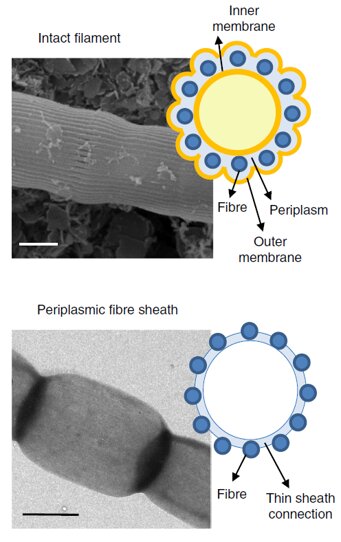Conductive features of cable bacteria
(in collaboration with the Meysman Group)
The cable bacteria demonstrate a novel evolution-optimized type of cell-to-cell interactions based on the charge transport over centimeter distances implemented via highly conductive fibre network.
We apply a combination of various electrochemical techniques (impedance spectroscopy, electrochemical gating, voltammetry) to investigate conductive conduits in intact cable bacteria and in periplasmic sheaths extracted by SDS/EDTA treatment as well as influence of different ions on interfacial charge distribution and resistance of the filaments.
The multidisciplinary team consists of:
- Department Biology, UAntwerp, Belgium (team leader: prof. Filip Meysman)
- Departments Fysics and Biology, UHasselt, Diepenbeek, Belgium (team leader: prof. Jean Manca)
- Department of Bioengineering, UAntwerp, Belgium (team leader: prof. Karolien De Wael)
- Departments Biotechnology, Bionanoscience and Quantum Nanoscience, TU Delft, Nederland (team leader: prof. Herre van der Zant)
- Vlaamse Fonds Wetenschappelijk Onderzoek (FWO)
- Nederlandse Organisatie voor Wetenschappelijk Onderzoek (NWO)
- European Research Council (ERC).

Key publications:
- A highly conductive fibre network enables centimetre-scale electron transport in multicellular cable bacteria, F. J. R. Meysman, R. Cornelissen, S. Trashin, R. Bonné, S. Hidalgo Martinez, J. van der Veen, C. J. Blom, C. Karman, J. Hou, R. Thiruvallur Eachambadi, J. S. Geelhoed, K. De Wael, H. J. E. Beaumont, B. Cleuren, R. Valcke, H. S. J. van der Zant, H. T. S. Boschker and J. V. Manca, Nature Communiations (2019), 10, 4120.
- The organo-metal-like nature of long-range conduction in cable bacteria, D. Pankratov, Hidalgo Martinez S., C. Karman, A. Gerzhik, G. Gomila, S. Trashin, H.T.S. Boschker, J.S. Geelhoed, D. Mayer, K. De Wael and F.J.R. Meysman, Bioelectrochemistry (2024), 157, 108675.